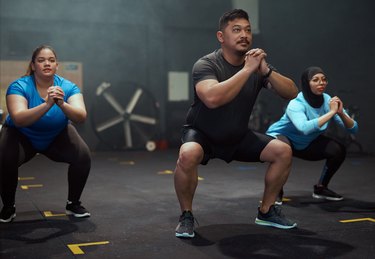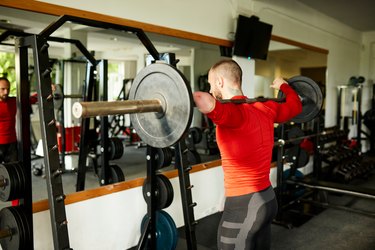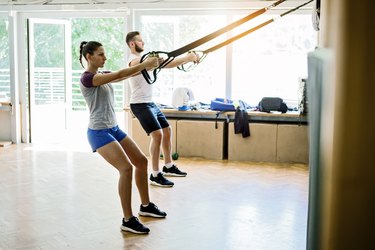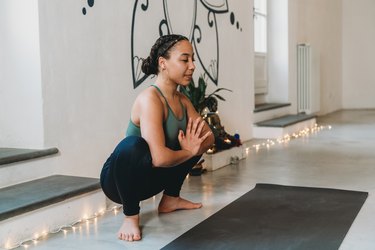

No matter what anyone tells you, squatting doesn't actually cause knee pain. Instead, most knee pain when squatting is actually due to muscle imbalances or limited mobility. That's because your joints are affected by the movement in your joints directly above and below them.
After all, your knee joint is located between your hip and ankle joints, so any issues in your feet, ankles, hips and glutes can end up affecting you knees.
Video of the Day
Video of the Day
That said, learning how to fix knee pain from squatting doesn't have to be that tricky. Here are five form adjustments and mobility drills you can do the next time you get low.
1. Grip With Your Feet
Strong, active feet provide a solid base of support and help properly distribute forces throughout your joints. If you don't know how to actively engage with the ground using your feet, other joints — including your knees — take on excessive load when you squat.
Think of how you would grab a heavy dumbbell with your hands: You wrap your fingers around the handle and grip hard. Ideally, your feet should be doing something similar when you squat.
Focus on grabbing the ground with your toes and think about pushing the floor away from you with your feet. If you're struggling to activate your feet, try squatting in your socks so you can better feel your connection with the ground.
Imagine you are straddling a huge crack in the earth. Your job as you squat is to try to spread that crack apart with your feet.
Another thing to watch out for is your heel(s) popping off the floor. The ball of your foot, its outside edge and your heel should all stay in constant contact with the ground while squatting or lunging.
"Keeping the heel 'glued' to the ground can prevent knee pain from squatting," says Michelle Kania, CSCS, a certified strength and conditioning specialist and owner of One Day Better Training.
2. Work on Your Ankle Mobility
If your ankles don't move well, your knees pick up the slack. Poor ankle mobility is one of the most overlooked obstacles to squatting with great form
According to a March 2015 study in the Journal of Human Kinetics, ankle dorsiflexion (raising your toes toward your shins) plays a major role in the depth of your squat, aka how low you can go. This means if your ankles don't bend very well, you'll have a hard time getting into the bottom of a squat.
You can improve your ankle mobility by including some ankle drills in your warm-up. The half-kneeling kettlebell ankle drill below uses the weight of the kettlebell to gently drive your knee forward over your toe. Be sure to keep your heel down on the floor throughout the rep.
"Tight calves can also make it harder for your knee to move past your toes without your heel popping up off the ground," Kania says.
Spend a couple of minutes at the start of each workout foam rolling your calves to help relax these overly tight muscles.
Half-Kneeling Kettlebell Ankle Drill
- Start in a half-kneeling position and place one knee down on a pad so that it's directly beneath your hip. Your back toes should be flexed and pointing to the floor. Bend your front knee so it forms a 90-degree angle. This foot should remain flat on the floor throughout the exercise.
- Place a mid-weight kettlebell on top of your front side. The weight should be heavy enough to push you into the stretch, but not so heavy that it causes pain or excessive leg fatigue.
- Use the weight of the kettlebell to gently guide your knee out over your toe. Keep the knee in alignment with your toes and do not allow it to travel in toward the middle of your body.
- Go as far as you can while still keeping your front heel glued to the floor. When you reach end range ankle dorsiflexion, return to the starting position.
3. Lead With Your Hips and Knees
One of the biggest mistakes that contributes to knee pain when squatting is starting the exercise from your ankles. When you bend at your ankles first, your knees automatically shoot out over your toes without your hips sh0oting behind as a counterbalance. This causes your knees to absorb nearly the entire load as you squat.
To avoid this problem, begin each rep by moving your hips and knees. Think about squatting both back and down so your hips take on their fair share of the load. This way you'll also be able to use your glutes and core to support yourself throughout the movement.
It might also be helpful to do box squats (see below) to help you understand how far back your hips should go.
Box Squat
- If possible, select a box that allows you to squat down so your thighs are parallel with the floor. People who are tall, those with limited hip or ankle mobility or those with active knee pain may need to use a higher box.
- Start standing in a tall and tight upright position.
- Initiate the movement by reaching your hips back and bending your knees. Think about sitting both back and down. Grab the floor and try to spread it apart with your feet.
- Continue descending into your squat until your hips reach the box.
- Finish the movement by driving your feet into the floor to stand up. Keep your chest tall throughout the rep. Don't allow yourself to excessively fold over or lean forward.
4. Strengthen Your Glutes
Sometimes, to fix knee pain from squatting, you kneed to focus on your hips and glutes. Your glutes, and primarily your side glutes, play a big role in stabilizing your knee joint. So any weaknesses there can make things go off-track.
But, of course, most lower-body workouts ignore the side glutes (gluteus medius and minimus). Fix that by doing side-to-side exercises like lateral band walks, clamshells and side squats.
Related Reading
5. Choose a Different Squat Variation
If you struggle with knee pain during squats, try a different squat variation (think: goblet squats, double kettlebell squats, barbell front and back squats, air squats, sumo squats).
While front-loaded squats put more stress on your quads and knees, they also use a pretty upright posture that some people prefer. Meanwhile, backloaded squats take some pressure off of the knees, but require you to hinge more at the hips and move your knees farther over your toes.
In the end, everyone is a bit different in what works for them. So test out the variations and stick with the ones that feel most comfortable on your knees. Over time, as you build strength and mobility in your legs, you may be able to expand your squat repertoire.
Was this article helpful?
150 Characters Max
0/150
Thank you for sharing!
Thank you for your feedback!



